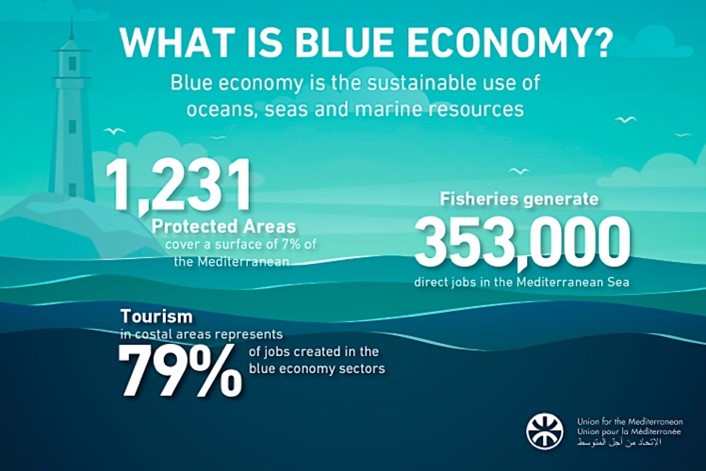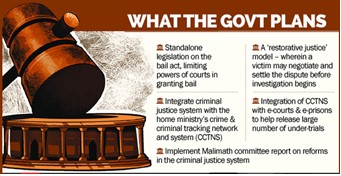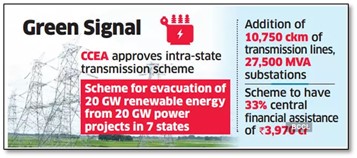Wednesday, 23rd February 2022
Data privacy control
In News
Tech giants like Apple and Google have recently taken steps to give users greater control over the use of the data they generate online.
About the News
- It is seen both as a boost to user privacy and as a step towards consolidating further the position of these companies.
- Previous business model of Internet giants was to provide “free” services hinged on collecting user data and monetising the information in the form of advertisements.
- With increasing global spotlighting on data privacy issues, big tech firms — Facebook, Apple, Google, Amazon — have come under increasingly intense antitrust scrutiny for their attempts to monopolise their businesses.
What are the major initiatives by tech companies aimed at data privacy?
- App tracking transparency (ATT): Apple has added the feature to iPhones and iPads, which requires apps to seek users’ permission to track their activity across other apps and websites.
- Privacy Sandbox: Google has proposed to bring sandbox for Android devices that would “limit” the sharing of user data with third parties, and operate without cross-app identifiers, including advertising IDs. The advertising ID is a unique, user-resettable ID for advertising provided by Google Play services.
- FLoC: Google had proposed to replace cookies with Federated Learning of Cohortse., instead of interest-based advertising that was enabled by cookies, users would be bunched into groups with comparable interests.
- Topics: It is an initiative by Google through which the company’s Chrome browser would curate a user’s top interests in a week based on browsing history. It will exclude categorisation based on sensitive categories such as race, religion, sexual orientation, etc.
What are the major issues?
- Financial loss: Companies who were dependent on advertising as a revenue model will face losses as the ATT feature cuts their access to the data of iPhone users, which they harvested and used for targeted advertising. For example, Meta, Facebook’s parent is expected to get financial hit from Apple’s move “in the order of $10 billion” for 2022.
- Concentration of data: Solutions such as the Privacy Sandbox mean the phasing out of cookies which are currently the go-to tech for online advertisers.
- Data monopoly: Privacy advocates have argued that rather than stopping the tracking of users’ online activity, Google’s other initiative i.e. FLoC put the tracking directly into Google’s hands. Antitrust investigations were opened in the UK and the European Union forcing Google to give up the FLoC project.
- Disadvantage for Facebook: Apple’s move to limit tracking by apps has tipped the scales in favour of Google as far as online advertising is concerned. Notably, online advertising is Google’s core business, unlike Apple.
- Choice to opt out: Having got the choice to opt out of app tracking, many iPhone users have done so for apps such as Facebook, stymieing the primary channel for the company’s online advertising business.
- Cost inflation for online ads: With the reduction in the volume of data gathered from users’ online activity such as e-commerce and search engine queries, and other social media activity, it has become more difficult for companies like Facebook to target specific ads, potentially cutting the incentive for advertisers to run promotions on the platform.
- Third-party use dependent companies: Unlike Google and Amazon, companies like Facebook depends heavily on tracking the third-party activity of users to generate data. In the case of Google or Amazon on the other hand, users help generate first-hand data through their queries. Online ads targeted at iPhone users typically have higher conversion rates than Android, so these users opting out of app tracking is especially damaging.
- Small business: Cost of acquiring customers for small businesses advertising on platforms like Meta’s Facebook and Instagram went up with some of these small businesses moved their “whole ad budget” to search ads on Google.

Sources:
India’s statement on Ukraine crisis
In News
At an emergency meeting called by the UNSC on the Russia-Ukraine crisis, India issued statement on the Ukraine crisis.
Background
- At the heart of the current crisis between Russia and Ukraine is NATO (North Atlantic Treaty Organization), which the latter wishes to join.
- Russia, fearing NATO’s increased influence in the border areas, started deploying forces at the Russia-Ukraine border.
- In 2014, Russia annexed Crimea from Ukraine. This led to an increased fear of attack by Russia on Ukraine.
- Russia recently signed a decree to officially recognise the independence of two separatist regions in eastern Ukraine — Donetsk and Luhansk.
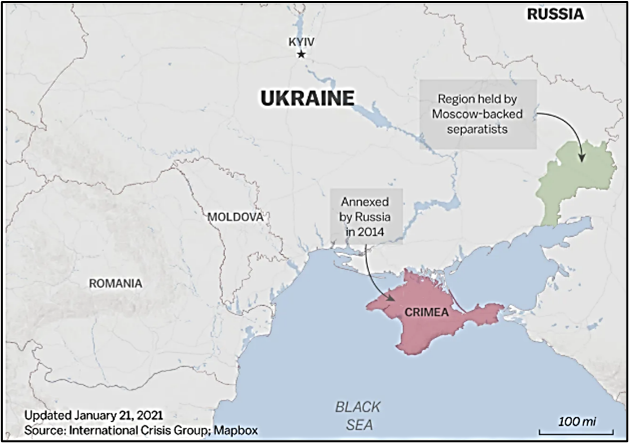
India’s statement
At emergency UNSC meeting India said that the escalation of tensions along the border between Ukraine and the Russian Federation was a “matter of deep concern”, and that these developments had the potential to undermine peace and security in the region.
Key Takeaways
- India has not condemned Russia’s statement of recognition of the two separatist regions of Donetsk and Luhansk. This may be viewed as tacit support to Russia by the western bloc led by US.
- India has talked about “these developments” without naming Russia’s actions at all. This statement may be seen as only an advice to Russia to not take further steps that might inflame the situation further.
- Internationally, Russia’s actions are widely seen as violation of a sovereign nation’s territorial integrity, and a breach of international law and agreements — including the Minsk Agreements of 2014 and 2015 between Ukraine and the Russian-backed separatists, and the 1994 Bucharest Memorandum, originally signed by the Russian Federation, the US, and UK on the matter of Ukraine.
- India’s concerns are majorly centred around the Indians stuck in Ukraine. More than 20,000 Indian students and nationals live and study in different parts of Ukraine, including in its border areas.
- New Delhi has so far issued at least three advisories to repatriate students back to India.
- The statement underlines India’s insistence on diplomacy, which has been articulated by the government on several occasions, to bridge divergent interests. India has categorically stated that military escalation should be avoided.
- India has welcomed the intense efforts underway, including through the Trilateral Contact Group (of Ukraine, the Russian Federation, and the OSCE) and under the Normandy Format (involving Germany, Russia, Ukraine, and France).
- India has asked “all sides” to intensify diplomatic efforts to reach an amicable solution at the earliest. This is again a time-tested Indian line — in which it refrains from blaming any one side for not being cooperative.
- This is in contrast with the views of the west that blames the Russian President for the current situation, who himself has said the threat to Russia from NATO’s eastward expansion is responsible for tensions.
- Indian stand may be viewed as condoning the Russian action, as India has not used the words “territorial integrity and sovereignty”. This may be seen as a double standard as India has always referred to such terms in the context of China’s aggressive behaviour.
- But this is India’s diplomatic dilemma — India has very important strategic ties with Russia, and is dependent on it for crucial military supplies.
- A large share of India’s military hardware is of Russian-origin — and this is a consideration it cannot overlook, especially at a time when a tense border standoff with China is ongoing.
Sources:
CRZ Rules
In News
The Brihanmumbai Municipal Corporation completed its inspection of Union Minister Narayan Rane’s bungalow in Juhu following the complaint of illegal construction and flouting of Coastal Regulation Zone (CRZ) rules.
About the News
- The BMC’s action came after a Right to Information (RTI) activist filed a reminder complaint alleging it did not take any action on his previous complaints regarding illegal construction of the bungalow.
- The bungalow has been in the news for the past few years over alleged illegalities, since the bungalow, built within 50 metres of the sea, violated CRZ rules, 1991 as being in the NDZ(No development zone).
CRZ Notification, 2018
CRZ rules were first issued in 1991, which have been amended 2011 and later in 2018 by notifications. The 2018 notification brought in significant changes that allowed various activities under the previously restricted zones. These include:
- Allowed eco-tourism activities such as mangrove walks, tree huts, nature trails, etc in eco-sensitive areas, demarcated as CRZ-IA. Sea links, salt harvesting and desalination plants and roads on stilts are also allowed in CRZ-IA. These were off -limits for tourism activities according to the 2011 notification.
- In CRZ-II, a substantially built-up area, project developers can now increase the floor area ratio or floor space index and build resorts and other tourism facilities.
- The latest notification drastically shrinks NDZ (No development zone) to 50 m from HDL in densely populated areas (where population exceeds 2,161 per sq km as per the 2011 Census). This technically allows resorts, hotels, and tourism facilities to be built right up to HTL.
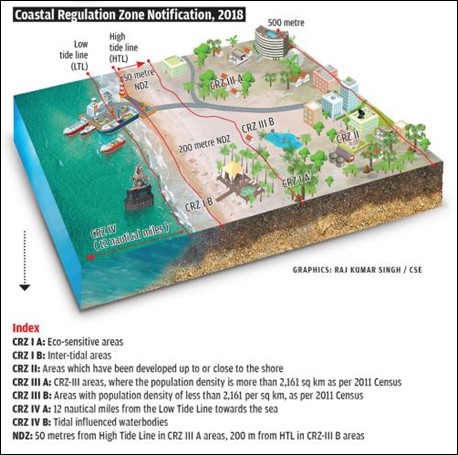
Prohibited activities within CRZ
- New Industries and expansions of existing ones
- Manufacture or handling of oil, storage or disposal of hazardous substances
- Setting up of new fish processing units
- Land reclamation, bunding or disturbing the natural course of seawater with exceptions.
- Discharge of untreated waste and effluents; Dumping of city or town wastes,
- Port and harbour projects in high eroding stretches of the coast
- Mining of sand, rocks and other sub-strata materials,
- Drawal of ground water, disposal of plastic into the coastal waters etc.
Sources:
Sardar Ajit Singh
on 23rd February 1881, Ajit Singh, uncle of famous Indian freedom struggle hero Bhagat Singh, was born at Khatkar Kalan village in then Jalandhar district of pre-partition Punjab. Sardar Ajit Singh had led the Pagri Sambhal Jatta movement against the exploitative farm laws enacted by the British in 1906. The British Government brought in three laws in 1906— the Doab Bari Act, Punjab Land Colonisation Act and the Punjab Land Alienation Act. The British Government was compelled to repeal the three laws in May 1907. But Lala Lajpat Rai was arrested on 9th May and Ajit Singh on 2nd June 1907 and deported to Mandalay prison in Burma for six months. After his release from Mandalay prison, Singh attended the Surat session of the Congress and went on to form a revolutionary organisation called the Bharat Mata Society in 1907. He later launched the Bharat Mata Book Agency, which, because of its strident anti-government, propagandist publications, attracted the attention of the British government. In Paris, he also founded the Indian Revolutionary Association (Bharatiya Krantikari Sangh).On the night of 14-15 August 1947 midnight, after listening to the famous Pandit Nehru’s ‘Tryst with Destiny’ speech, he felt overwhelmed and breathed his last at about 3.30 am. He was to address a public meeting to celebrate Indian freedom after daybreak.

Source:
Government’s Capex Push
In News
In recent times there has been sustained push on capital expenditure by the government to recover from pandemic.
What is capital expenditure?
- Government expenditure is of two types—revenue expenditure and capital expenditure. Capital expenditure (Capex) is money spent to create or acquire fixed assets—machinery, equipment, land, building, investment in shares, health facilities, education, purchase of new weaponry, etc.
- While capital expenditure creates assets for the future, revenue expenditure is recurring in nature.
Recent Trends in Capex Budget
- Government has focused on improving the quality of expenditure in both 2020-21 and 2021-22.
- Capex registered a YoY growth as it increased from 1.6% of GDP in 2019-20 to 2.2% of GDP in 2020-21 PA. In 2021-22 BE, Capex reached to the tune of Rs 5.54 lakh crore (2.5% of GDP).
- As a proportion of total expenditure, Capex has been estimated to increase from 12.1% in 2020-21 PA to 15.9% in 2021-22 BE.
- Budget 2022-23 announced an increase of 35.4% in the Capex outlay to Rs 7.50 lakh crore or 2.9% of the GDP, to kickstart a “virtuous cycle of investment”.

Nature and Component of Capex
- The expenditure policy of the government during 2021-22 has been characterized by restructuring and prioritization of spending in sectors having a long-term impact on output.
- There is a strong seasonality in Capex by the Government. A large proportion of capital spending takes place in the second half of the year.
- The focus of capital expenditure from April to November 2021 has been directed towards infrastructure-intensive sectors like roads and highways, railways, and housing and urban affairs.
- The capital expenditure for 2022-23 has been pegged at Rs 7.5 lakh crore. Together with grants in aid for creation of capital assets (including MNREGA works), the effective capital expenditure for the next year is budgeted at Rs 10.67 lakh crore.
- In addition, the Centre has also put in place several incentives to boost the capital expenditure by the States such as Scheme for Special Assistance to States for Capital Expenditure.
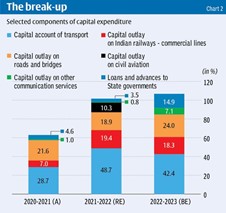
Government thrust on Capex: The multiplier effect of Capex
- The Economic Survey 2022 states that the targeted focus on capital expenditure, with its resulting multiplier effects, will be vital in sustaining economic growth.
- In the Budget speech, Finance Minister said capital investment holds the key to speedy and sustainable revival and public spending is required to take the lead.
- Emphasis on public capital expenditure will have a multiplier effect on income augmentation, employment generation and, consequently, demand rejuvenation.
- These will also “crowd in” private investment. Capital formation, both public and private, will provide a stepping stone for growth not only in the short-term but also in the long-term.
- Capital expenditure is expected to achieve this through a multiplier effect (a change in rupee value of output with respect to a change in rupee value of expenditure).
- According to the RBI Bulletin, in India, the multiplier effect of capital expenditure made by the central government is estimated at 45, whereas for state governments it is around 2.
- On the supply side also, it can facilitate labour productivity. Thus, capital expenditure is an effective tool for countercyclical fiscal policy and acts as a macroeconomic stabiliser.
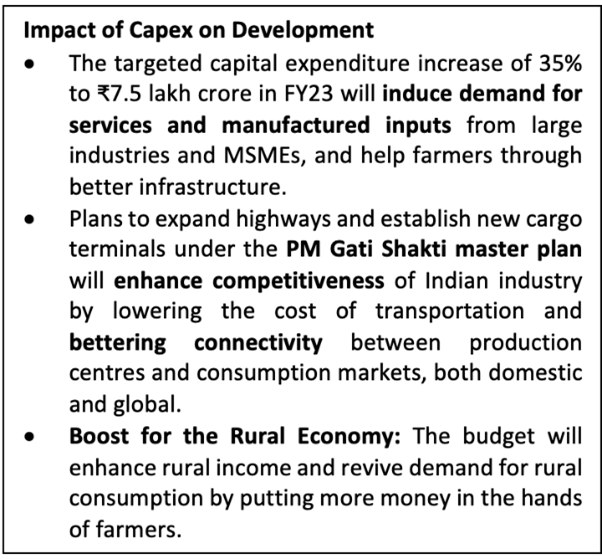
Capex and Fiscal Consolidation concerns
- According to Economic Survey 2021-22, the agile fiscal policy approach adopted by the Government, coupled with the buoyant revenue collection received so far this year, has created headroom for taking up additional fiscal policy interventions based on the need of the evolving situation.
- As the economy grows further, the revenue collection from all the sources is expected to be more robust, which will help to limit fiscal deficit during 2021-22.
- A robust economic growth path and various tax policy and administration reforms undertaken over the last few years will be fundamental in sustaining the buoyant revenues in the medium term, and thus, be on track with the fiscal path outlined by the Medium-Term Fiscal Policy Statement.
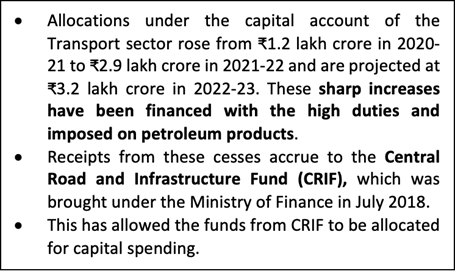
Ways to Finance Capex
- Apart from budgetary spending, Extra Budgetary Resources (EBR) g., Government fully serviced bonds, NSSF loan and other resources, disinvestment proceeds etc. have also been mobilised to finance infrastructure investment since 2016-17.
- Government has raised EBRs of Rs 6.04 lakh crore from 2016-17 to 2020-21, of which Rs 1.43 lakh crore have been mobilised from the issue of Government fully serviced bonds and Rs 4.61 lakh crore have been raised through financial support extended through loans from NSSF.
Concerns due to rising Capex
- The multiplier effect will not consider the time-lag to kick in, capacity availability in the industry, and undisposed inventory and work in progress before the pandemic-induced lockdowns.
- Given the pandemic, the multiplier effect loses value if people hold idle cash out of fear of unforeseen expenses and survival paramountcy during possible future lockdowns.
- Inflation-induced price rise, particularly in food and health, could also affect the multiplier impact as households would tend to give them priority over other consumption items.
- Also, capital expenditure funded by the government through heavy domestic borrowing has the potential of crowding out capital expenditure by the private sector, thus severely weakening the multiplier effect.
- For viability of a particular capital project, the Internal Rate of Return (IRR) should be more than the Hurdle Rate (HR)/Cost of Funding (CoF). The IRR on infrastructural projects on a global scale ranges between 8% and 12%. However, trends in India reveal that the range is 6-8% only, which can be a deterrent to private sector funding of infrastructural projects.
- Low IRR in the Indian context has traditionally been a result of cost and time overruns.
- The reasons behind these overruns are lack of forward-planning, identification of risk factors and poor collaboration amongst stakeholders. Besides, the regulatory uncertainty arising out of sudden legal, legislative changes or change in government policies like the imposition of the retrospective tax (like Vodafone and Cairn India cases) adversely impacts IRR margins.
- What is also equally important is the long-term quality of capital creation, as poor quality necessitates recurring maintenance costs attached to a project after its completion.
- Some states have raised concerns about the enhanced capex allocation coming at the cost of a reduction in grants in aid, revenue deficit grants, subsidies for food, fertiliser, fuel and allocation for MGNREGA.
Conclusion:
By and large, the capex, both infrastructure and industrial capex is about 5-6 per cent of the GDP size. We have to take it at least to double in the medium term, which requires all avenues to channelise savings and savings will come from based on the needs of each class of investors. Economic growth has to come from a virtuous cycle of private investment with private sector having a larger and larger economic role, while Government's role would be that of a facilitator. Moreover, the Indian capital market has to mature to enable investors to attract long term funds
Question: Explain the reasons for rising capital expenditure by government in recent times. What can be the possible impacts of this trend?
Sources:
- Budget 2022: Share of capital expenditure is the highest in 19 years
- Union Budget: Booster dose of capex for economic immunity | VIEW
- Five reasons why the Survey says the Budget has room for fiscal stimulus
- Need capex to boost growth, private sector investment: Survey
- The Budget spells green shoots for agri-subsectors
- Highest capex allotment in Budget 2022 will fast-track MSME sector development
- What ails Indian states' capital expenditure
- View: Increased capex will boost growth
- Opinion: Why Nirmala Sitharaman's Budget Is Risky
- Can capital expenditure boost the economy?
- Here’s why government increased capital expenditure in Union Budget 2022
- View: Budget is good on the capex front, but the big question is how well the projects are executed
- Opinion: Budget should put money in the hands of poor, not call for capital expenditure
- WHAT IS CAPITAL EXPENDITURE
- Unravelling the Centre’s capital expenditure push
- Budget 2022 Explained: Why FM is pushing for enhanced capex allocation
- FM Sitharaman has made a prudent choice in pushing capex instead of demand stimulus
- Union Budget 2022: Capex to push pedals of virtuous cycle
- Here’s why government increased capital expenditure in Union Budget 2022
- Explained: Why are states worried about high capex in Budget 2022?
- Budget’s capex push will have multiplier effect
- Government Finances 2020-21: A Half-Yearly Review*
- India needs to double capex in medium term to fund infra: DEA Secy:
Char Chinari' island
This is image of the Char Chinar Island on Dal Lake. Jinxed by vanishing mighty chinars, iconic island Char Chinari in the middle of the Dal lake in Srinagar has been brought to life again. At the pursuance of the J&K LG, two tall Chinar trees were planted on the picturesque island with Zabarwan hills in the backdrop. This will be for the second time in the past decade that Chinar trees, which otherwise survive for centuries, will be planted on the island. Earlier, the 2014 floods left two mighty chinars damaged, denting its iconic view from the boulevard around the lake. The island, in fact, owes its name to Chinar trees, as Char Chinari means four Chinars. The floriculture department will be maintaining a constant vigil on the Chinar trees' growth on the island.
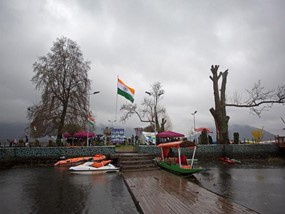
Source:
Panruti cashews
- Context: The Tamil Nadu Cashew Processors and Exporters Association (TNCPEA) has applied for a Geographical Indication (GI) tag for Panruti
- Though slightly small in size, Panruti cashews have a unique value in the market. Colloquially known as the ‘goldmine’ of Cuddalore, it has a huge demand across India and the world.
- Panruti, in Cuddalore district, is ‘Cashew Central’ as far as Tamil Nadu is concerned. Out of the total 1,42,000 hectares under cashew cultivation in the State, Panruti accounts for about 35,000 hectares.
- The cashew apples from Panruti are also uniquely distinctive. The apple is round-shaped and bright red in colour.
- According to an international study, out of six cashew varieties selected from different parts of India, the Panruti variety showed significant results in high raw protein content of 23.0g/100g.
- The moisture content of the Panruti cashew is also low when compared to other varieties.
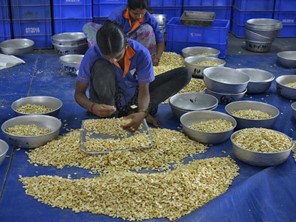
Source:
Conversion therapy - Edukemy Current Affairs
- Context: National Medical Commission has forbidden Conversion Therapy.
- The National Medical Commission (NMC) has told the Madras High Court Conversion therapy by medical professionals — an illegal practice that queer people are subjected to in order to ‘cure’ them of their sexual orientation or gender — amounts to professional misconduct.
- The council made its stand clear while making a submission on a recommendation of an expert committee constituted to modify the MBBS Syllabus so that medical students can be sensitised of sexual orientations of people belonging to LGBTQIA+ community.
- The NMC has now said that action should be taken against medical professionals who prescribe such illegal practices.
- The Section 27 of the National Medical Council Act, 2019, specifically provides that State Medical Councils should ensure the compliance of the Code of Professional and Ethical Conduct and wherever it has the power, the State Medical Council should take disciplinary action when it comes to professional or ethical misconduct.

Sources:
Omicron subvariant BA.2
- Context:2 subvariant of the Omicron has become a matter of concern for several medical scientists and experts across the globe.
- The Omicron subvariant BA.2, is the new Covid-19 strain, which the experts have warned that it is capable of causing serious illness just like the 'Delta' variant.
- A Japanese study led by researchers from the University of Tokyo has concluded that the BA.2 subvariant of the Omicron coronavirus variant is not only faster at spreading, but may also cause more severe disease.
- As per the study, the vaccine-induced humoral immunity fails to function against BA.2 like BA.1.
- As per WHO, while 2 is more transmissible than BA.1, the subvariant is not more severe.

Source:
Kavach’ system
- Context: The East Central Railway (ECR) is set to install advanced signalling-cum-safety system dubbed “Kavach”
- This is being done as a safety measure on railway tracks to maintain smooth running of long-distance trains.
- The system will be first installed on the Pt Deen Dayal Upadhyaya Junction - Gaya-Dhanbad Grand Chord route.
- Kavach is an anti-collision technology which would help us to attain zero accidents on railway tracks.
- The system works on micro processing, global positioning system and radio communication. The device will be installed inside the cabin of locomotives linking directly through radio system to stations located on the entire route.
- The system is developed by Research Design and Standards Organisation. The device has inbuilt automatic brake system which will check the possibilities of front or rear collision of passenger trains through sensor.

Source:
Labour laws could be good for business in the country: LM
Essence: As per the author, unemployment crisis is plaguing the country, as working age population is increasing and the number of employed people is decreasing. The author emphasizes that the failure to acknowledge the array of constraints that hold businesses back and pinning the blame on labour regulations are poor responses to a pressing problem.
As per the author, weakened labour laws are contrary to the government’s push for an Atmanirbhar Bharat and skill development as occupational safety and health, social security, training and apprenticeships, and appropriate wages are essential investments in productivity.
The consolidated labour laws have few gaps, for example, the Occupational Safety, Health and Working Conditions Code applies to factories that have at least 20 workers with power, or 40 workers without power thus excludes an estimated 99% of the manufacturing sector. These gaps need to be addressed as dilution of labour laws is neither good for the worker nor for the economy.
Why you should read this article?
- To understand the unemployment status in Uttar Pradesh and the reasons for the same.
- To know the importance of the labour codes for the economy.
- To know about the gaps in the 4 labour codes.
Source:
Looking outward, again: HBL
Essence: The article talks about the FTA that India has recently inked with UAE, which is also its third largest trading partner. With this India is again back on track of adopting outward looking policy which it shunned it for many years. India in this deal tried to learn from the mistakes of the past by gaining tariff free access to 90 percent of its exports. On top of that preserving its sensitive items such as dairy and plantation products. But more clarity would be needed on government procurement and rules of origin.
As the centre is on the CEPA drive with eight deals in the pipeline, it needs to strike the right balance between the opening of the economy and inviting competitive forces through FTA’s. India should try to learn from the lessons from the deals it signing as it will help to negotiating things better in its future deals.
Why should you read this article?
- To understand the nuances of the CEPA signed with UAE.
- To understand why India moved away from getting into FTA’s.
- To understand the lessons that it should learn from the deals that it enters.
Source:
Three important aspects of 2022 budget with long-term implications: IE
Essence: Increasing capital expenditure, reduction on some of the subsidies, high level of fiscal deficit and center’s proposal of providing states with long term interest free loan are among the features which can be deducted from Budget 2022-23. Authors are of the view that while all these features have their own benefits, there are some reservations which the government must consider.
Increasing capital expenditure should not be at the cost of revenue expenditures directed towards providing social safety nets. High fiscal deficit in the long term has the potential to become financially unsustainable in the long term. Article also bats in the favour of empowering states to borrow on its own while providing for some regulation.
Extraordinary circumstances have indeed forced the government in a tight spot but it must ensure that policy decisions taken to deal with it should be well analyzed.
Why should you read this article?
- To understand some steps taken by the government in fiscal management.
- To understand some of the critiques of these steps.
Source:
Female Solo Travel
Background
A female solo traveller is on a 50-day hitchhiking journey to send out a message that India is safe for women travelling alone.
About the Solo Traveller
- Najira Noushad, a 33-year-old homemaker took off the solo trip across India from Kuttanad to Mount Everest.
- Through her travel vlogs, she is trying to send across two messages- 'Admire India' and 'She can travel alone'.
- She avoids the convenient modes of transport like train, flight or bus and has been hitchhiking on trucks to reach each pit-stops.
- During nights she stays with the families of people she has hitchhiked with.
- According to her, hitchhiking allows her to experience the diverse culture and meet new people.
- She has so far covered 10 Indian States and is expected to cross into Nepal in the next 10 days.

Quote: "It is in all of us to defy expectations, to go into the world and to be brave, and to want, to need, to hunger for adventures. To embrace the chance and risk so that we may breathe and know what it is to be free."-Mae Chevrette
Source:
Share the article
Get Latest Updates on Offers, Event dates, and free Mentorship sessions.

Get in touch with our Expert Academic Counsellors 👋
FAQs
UPSC Daily Current Affairs focuses on learning current events on a daily basis. An aspirant needs to study regular and updated information about current events, news, and relevant topics that are important for UPSC aspirants. It covers national and international affairs, government policies, socio-economic issues, science and technology advancements, and more.
UPSC Daily Current Affairs provides aspirants with a concise and comprehensive overview of the latest happenings and developments across various fields. It helps aspirants stay updated with current affairs and provides them with valuable insights and analysis, which are essential for answering questions in the UPSC examinations. It enhances their knowledge, analytical skills, and ability to connect current affairs with the UPSC syllabus.
UPSC Daily Current Affairs covers a wide range of topics, including politics, economics, science and technology, environment, social issues, governance, international relations, and more. It offers news summaries, in-depth analyses, editorials, opinion pieces, and relevant study materials. It also provides practice questions and quizzes to help aspirants test their understanding of current affairs.
Edukemy's UPSC Daily Current Affairs can be accessed through:
- UPSC Daily Current Affairs can be accessed through Current Affairs tab at the top of the Main Page of Edukemy.
- Edukemy Mobile app: The Daily Current Affairs can also be access through Edukemy Mobile App.
- Social media: Follow Edukemy’s official social media accounts or pages that provide UPSC Daily Current Affairs updates, including Facebook, Twitter, or Telegram channels.

